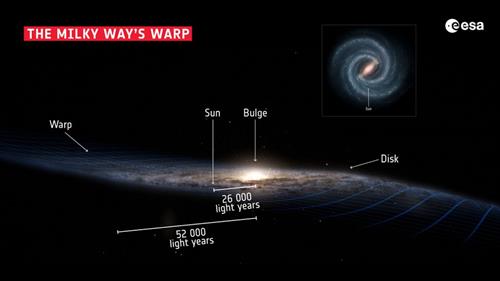-
What if?

Background: Our Milky Way Galaxy is estimated to contain 100-400 billion stars, with some estimates of up to one trillion stars! These are complex numbers to comprehend and even more difficult to calculate correctly. Much of our galaxy is obscured because we are embedded within it. We use various methods to expand our perspectives and better hone our perspectives.
For this hypothetical "What if" science dive, let's consider that the Milky Way contains 400,000,000,000 stars—400 Billion Stars!
What if we filled a regular piece of computer paper with 4,000 dots, and each dot represented an individual star in the Milky Way Galaxy? How many pages of paper would we need to represent the number of stars in our galaxy?

1. If there are 4,000 stars on a sheet of paper, how many sheets would we need to represent the 400 billion stars in our Milky Way Galaxy?
Answer: 400 billion stars divided by 4,000 stars per sheet of paper = 100 million pieces of paper!
To represent the number of stars in our estimate of the Milky Way Galaxy, we would need 100,000,000 pages—that is 100 million sheets of paper!
2. If one ream of computer paper contains 500 sheets of paper, how many reams of paper would represent the 400 billion stars in our Milky Way Galaxy?
Answer: Since each ream contains 500 sheets of paper, and we need 100,000,000 pages, we need only divide 100 million pages by 500 pages/ream.
100,000,000 pages divided by 500 pages/ream = 200,000 reams of paper!
Answer = 200 thousand reams of paper!
3. If one ream of computer paper is 2 inches thick, how many inches high would it reach if we stacked all those reams of paper one on top of the other?
Answer: If each ream of paper is 2 inches thick, all you need to do is multiply 200,000 reams of paper by 2 inches. 200,000 reams x 2 inches/ream = 400,000 inches!
4. How many miles high would our stack of paper reach?Answer: You need to know how many miles equals 400,000 inches.
1 mile = 5280 feet
1 foot = 12 inches
5280 feet times 12 inches = 63,360 inches/mile
By dividing 400,000 inches by 63,360 inches/mile = 6.31 miles high!
5. How does our stack of paper compare to the height of Mount Everest?
Mount Everest is approximately 5.5 miles tall!
Our stack of paper would be 6.3 miles tall!
That means our stack of paper would be almost 1 mile taller than Mount Everest!
That is a stack of paper over 30 thousand feet high!
If you've ever flown in a jet, you know they usually fly at around 30,000 feet! If you've seen a high-flying jet or looked down at the ground from the window seat, that's how high this stack of paper would be!
Imagine how many stars there are on all those pages!
Our galaxy is HUGE!!!
Milky Way galaxy: Everything you need to know about our cosmic neighborhood
The Milky Way is a barred spiral galaxy approximately 13.6 billion years old, with large pivoting arms stretching across the cosmos.
Milky Way quick facts:– Galaxy type: Barred spiral
– Age: 13.6 billion years (and counting)
– Size: 100,000 light-years across
– Number of stars: about 200–400 billion
– Rotation time: 250 million yearsThe disk of our home galaxy is about 100,000 light-years in diameter and just 1000 light-years thick.
Just as Earth orbits the sun, the solar system orbits the center of the Milky Way. Despite hurtling through space at speeds of around 515,000mph (828,000kmph), our solar system takes approximately 250 million years to complete a single revolution, according to Interesting Engineering. The last time our planet was in this position, dinosaurs were emerging, and mammals were yet to evolve.
If the center of the Milky Way were a city, we would be living in the suburbs, about 25,000 to 30,000 light-years from the city center. Life in the outskirts is good; we find ourselves nestled in one of the smaller neighborhoods, the Orion-Cygnus Arm, sandwiched between larger Perseus and Carina-Sagittarius arms.
On a clear night, void of light pollution, we can catch a glimpse of the bright lights of the galactic city streaking across the night sky. Our window into the universe, this milky white band of stars, dust and gas is where our galaxy gets its name.

Lying at the very heart of the Milky Way is a supermassive black hole called Sagittarius A*. About 4 million times the mass of the sun, this beast consumes anything that strays too close, gorging on an ample supply of stellar material, enabling it to grow into a giant. In 2022, we imaged this glutton at the core of our galaxy for the very first time, through an innovative technique allowing us to view the shadow of the black hole.
Why is our galaxy called the Milky Way?
According to the American Museum of Natural History (AMNH), our galactic home is called the Milky Way after its apparent milky white appearance as it stretches across the night sky. In Greek mythology, this milky band appeared because the goddess Hera sprayed milk across the sky.
Around the world, the Milky Way is known by different names. For example in China it is called "Silver River" and in the Kalahari Desert in South Africa it's called the "Backbone of Night".
Where is Earth in the Milky Way?
Earth is located roughly halfway to the edge of the Milky Way, about 26,000 light years from the center. We reside in a feature known as the Orion Spur (sometimes also called the Orion Arm), which is an offshoot between the larger Sagittarius and Perseus Arms that lie inwards and outwards of our location. What type of Galaxy is the Milky Way?
The Milky Way is a large barred spiral galaxy with a relatively small bar compared to most galaxies of a similar size. A central bar (or central bulge) is a circular to oval-shaped structure of old stars that lies at the center of spiral galaxies. Studying the Milky Way used to be notoriously difficult. Astronomers sometimes compare the effort to attempting to describe the size and structure of a forest while being lost in the middle of it. From our position on Earth, we simply lack an overview. But two ground-breaking space telescopes launched since the 1990s have helped usher in the golden age of Milky Way research. Major strides have been made, especially since the 2013 launch of the European Space Agency's (ESA) Gaia mission.
Telescopes enabled astronomers to distinguish the basic shape and structure of some of the closest galaxies before they knew they were looking at galaxies. But reconstructing the shape and structure of our own galactic home was slow and tedious. The process involved building catalogs of stars, charting their positions in the sky and determining how far from Earth they are.
Dutch astronomer Jan Oort, sometimes dubbed the master of the galactic system, was the first to realize that the Milky Way isn't motionless but rotates, and he calculated speeds at which stars at various distances orbit around the galactic center. It also was Oort who determined the position of our sun in the vast galaxy. (The Oort Cloud, a repository of trillions of comets far from the sun, was named after him.)
At the center of the Milky Way sits a supermassive black hole called Sagittarius A*. With a mass equal to that of four million suns, the black hole, discovered in 1974, can be observed in the sky with radio telescopes close to the constellation Sagittarius.

The Milky Way currently has four spiral arms, according to the National Science Foundation (NSF). There are two main arms — Perseus and Scutum-Centaurus — and the Sagittarius and Local Arm, which are less pronounced. Scientists still discuss the exact position and shape of these arms using Gaia data.
The Milky Way disk is not flat but warped, according to ESA. As it rotates, it precesses like a wobbling spinning top. This wobble, essentially a giant ripple, circles the galactic center much more slowly than the stars in the disk, completing a full rotation in about 600 to 700 million years. Astronomers think this ripple may result from a past collision with another galaxy.

https://www.space.com/19915-milky-way-galaxy.html


